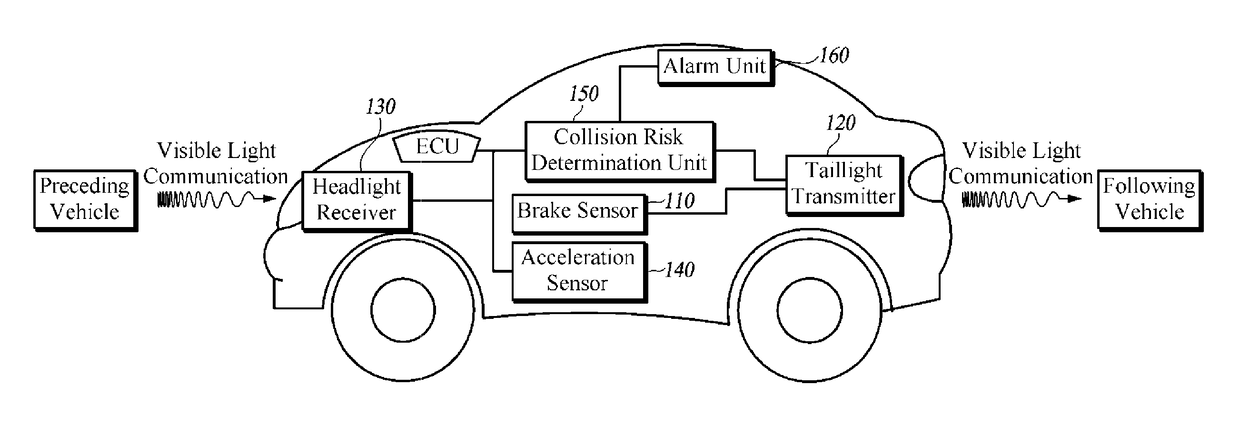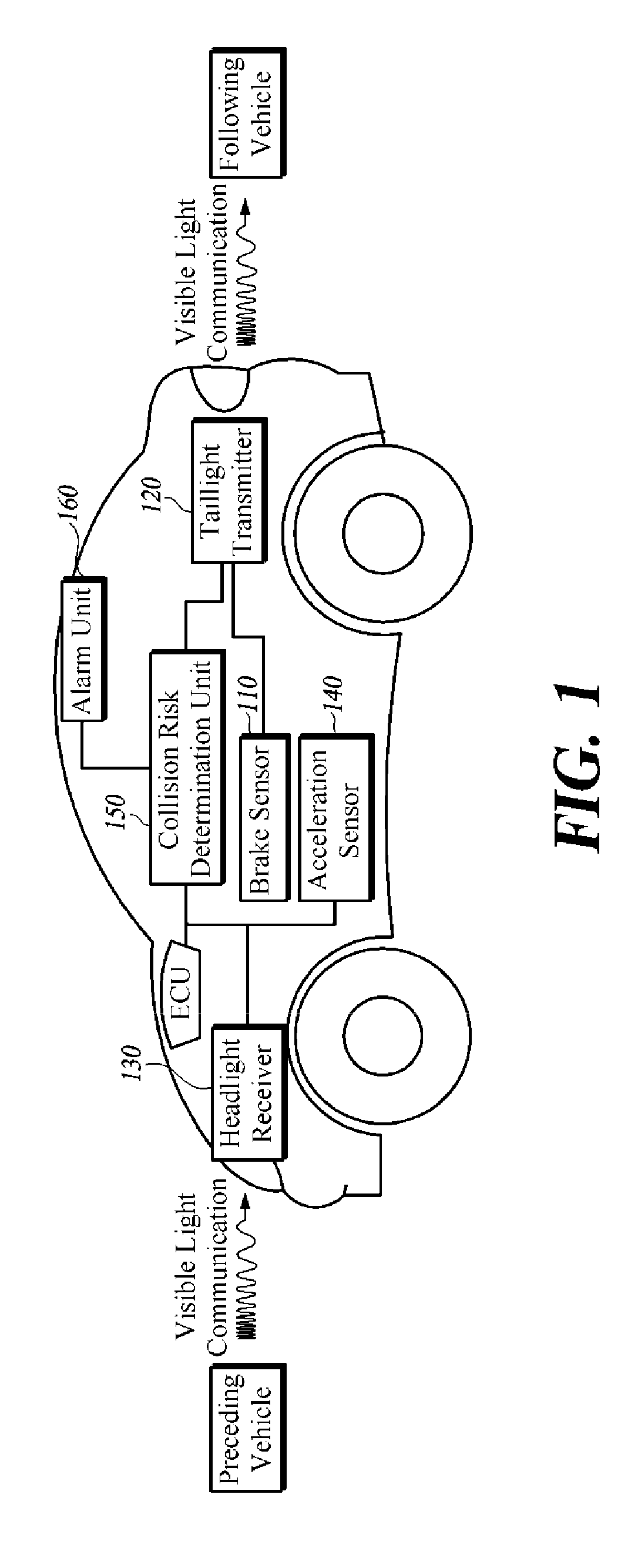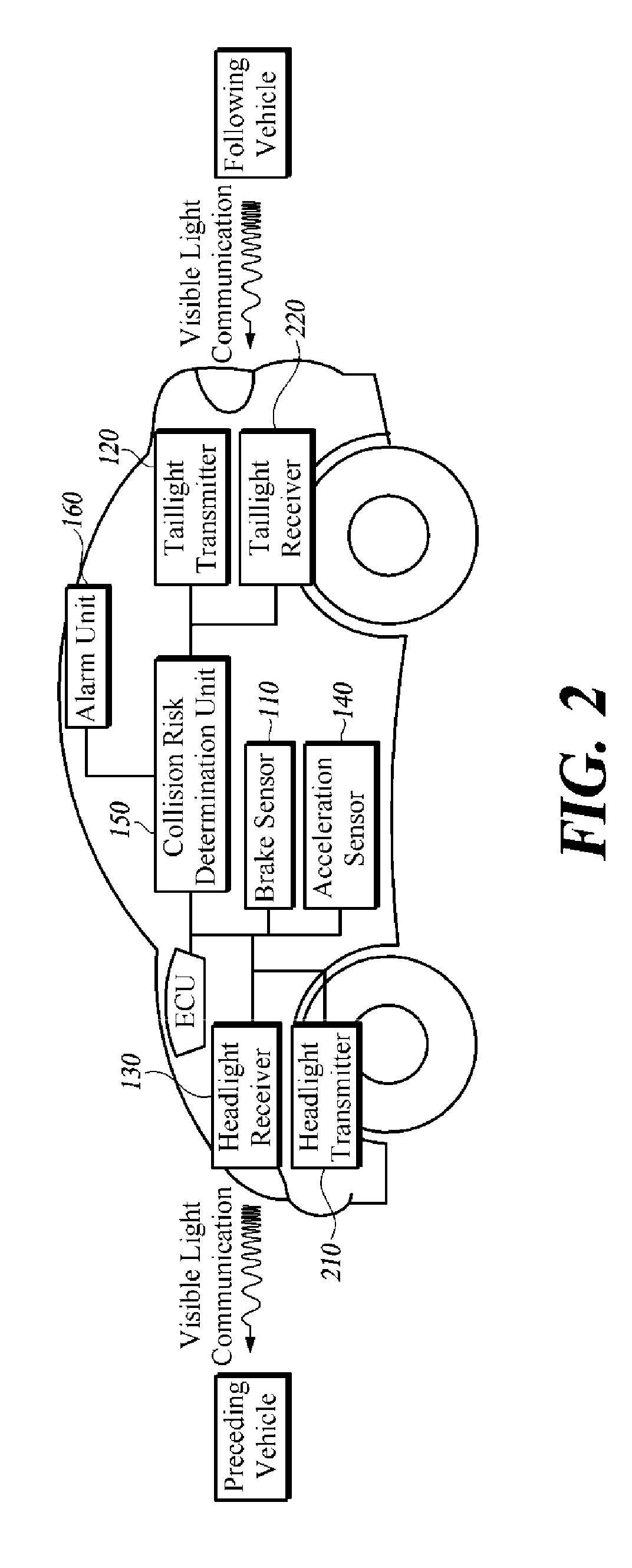Vehicle safety device using visible light communication
a safety device and vehicle technology, applied in the direction of pedestrian/occupant safety arrangement, vehicle sub-unit features, instruments, etc., can solve the problems of inability to provide concrete and practical means, drawbacks of existing radio frequency communication, accidents concerning the operation of vehicles, etc., to reduce the risk of collision, reduce the risk of fuel waste, and reduce the effect of collision risk
- Summary
- Abstract
- Description
- Claims
- Application Information
AI Technical Summary
Benefits of technology
Problems solved by technology
Method used
Image
Examples
first embodiment
[0033]FIG. 1 is a schematic block diagram of a vehicle safety apparatus using visible light communication according to the present disclosure.
[0034]Referring to FIG. 1, the vehicle safety apparatus using visible light communication according to the first embodiment includes a brake sensor 110, a taillight transmitter 120, a headlight receiver 130, an acceleration sensor 140, a collision risk determination unit 150 and an alarm unit 160.
[0035]The brake sensor 110 is installed on a braking system of the vehicle, for example, a brake pedal, which is installed with the vehicle safety apparatus using visible light communication according to this embodiment.
[0036]The brake sensor 110 distinguishes and detects when the driver operates the brake pedal with a weak strength from when the brake pedal is strongly operated. Therefore, the brake sensor 110 detects an event of operating the brake pedal by the driver below a preset strength to generate a weak deceleration signal, and detects anothe...
second embodiment
[0057]FIG. 2 is a schematic block diagram of a vehicle safety apparatus using visible light communication according to the present disclosure.
[0058]Referring to FIG. 2, the vehicle safety apparatus using visible light communication according to the second embodiment includes a headlight receiver 130, a headlight transmitter 210, a taillight transmitter 120, a taillight receiver 220, a brake sensor 110, an acceleration sensor 140, a collision risk determination unit 150 and an alarm unit 160.
[0059]The vehicle safety apparatus using visible light communication according to the second embodiment is equivalent to the first embodiment with additional components of the headlight transmitter 210 and the taillight receiver 220.
[0060]The headlight receiver 130, the taillight transmitter 120 and the brake sensor 110 shown in FIG. 2 are the same as those in FIG. 1. Therefore, only the difference of the acceleration sensor 140, the headlight transmitter 210, the taillight receiver 220, the coll...
third embodiment
[0077]FIG. 3 is a schematic block diagram of a vehicle safety apparatus using visible light communication according to the present disclosure.
[0078]Referring to FIG. 3, a vehicle safety device using visible light communication according to a third embodiment of the present disclosure includes a headlight receiver 130, a headlight transmitter 210, a taillight transmitter 120, a taillight receiver 220, a brake sensor 110, an acceleration sensor 140, a turn signal sensor 310, a collision risk determination unit 150, a distance measurement unit 320 and an alarm unit 160.
[0079]The vehicle safety apparatus using visible light communication according to the third embodiment is equivalent to the second embodiment with additional components of the turn signal sensor 310 and the distance measurement unit 320.
[0080]The headlight receiver 130, the headlight transmitter 210, the taillight transmitter 120, the taillight receiver 220 and the brake sensor 110 shown in FIG. 3 are the same as those i...
PUM
 Login to View More
Login to View More Abstract
Description
Claims
Application Information
 Login to View More
Login to View More - R&D
- Intellectual Property
- Life Sciences
- Materials
- Tech Scout
- Unparalleled Data Quality
- Higher Quality Content
- 60% Fewer Hallucinations
Browse by: Latest US Patents, China's latest patents, Technical Efficacy Thesaurus, Application Domain, Technology Topic, Popular Technical Reports.
© 2025 PatSnap. All rights reserved.Legal|Privacy policy|Modern Slavery Act Transparency Statement|Sitemap|About US| Contact US: help@patsnap.com



